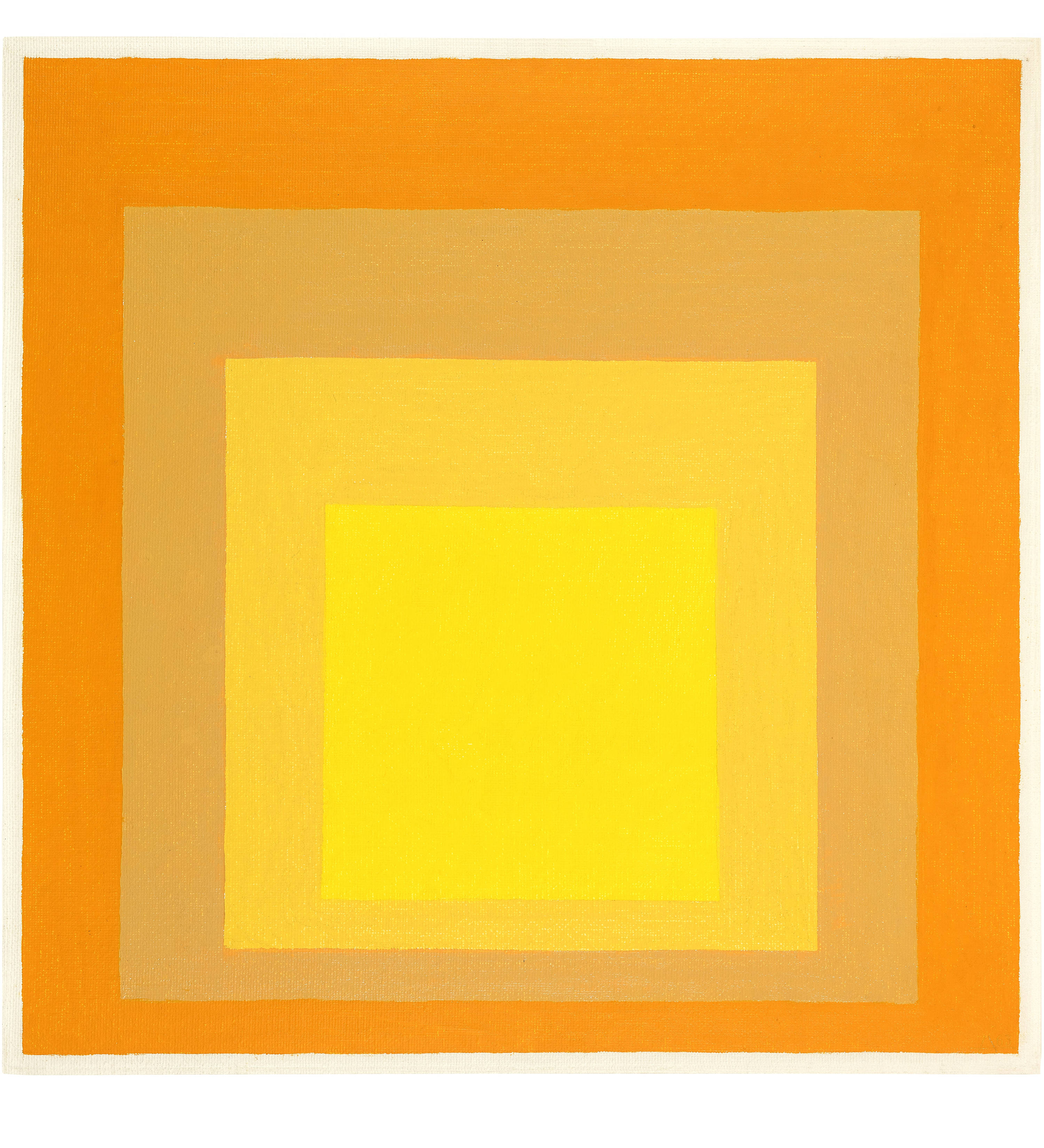- EN
Log in
- Live Auctions
- Past auctions
- More
- Gallery
- Art Dealing
- Publishing
- Kornfeld today
- The Story of Kornfeld
- Information
Note: The image cannot be displayed for legal reasons. For more information, see the PDF of the catalogue: Link to PDF
Bottrop 1888 - 1976 New Haven
1963
Oil on hardboard
61x61 cm
The artist's monogram and the year "A 63" scratched into the paint at the lower right, signed and dated "Albers 1963" by the artist in felt-tip pen on the reverse, titled "Study for / Homage to the Square: / "Joy"" at the top and inscribed in detail
With confirmation, dated 22 March 2017, by "The Josef and Anni Albers Foundation" that the painting will be included in the Catalogue Raisonné under the number JAAF 1963.1.85
Galerie Teufel, Cologne, acquired there in 1981 by
Hess Art Collection, from there to
International private collection
Washington 1965, The Washington Gallery of Modern Art, Josef Albers: The American Years, label on reverse.
In the original mounting, fresh in colour and in impeccable overall condition
"Study for Homage to the Square: Joy" belongs to the emblematic series "Homage to the Square", which Josef Albers began in 1950 and continued until his death in 1976. The pictures show interlocking, coloured squares and served the artist as a field of experimentation for his theories on colour. The square as a basic form can certainly be traced back to the influence of his teachers at the Bauhaus, Johannes Itten and Wassily Kandinsky.
In the work offered here, an intense, bright and warm yellow is at the centre of the composition. Around it are three larger squares representing variations of yellow-orange and orange (according to the artist's listing, the following were used: Lemon Cadmium #1, Naples Yellow, Naples Yellow Reddish and Cadmium Yellow Deep #4). With the choice of the title "Joy", Albers refers to the evocative power of this colour combination, which conveys a kind of "feeling of happiness". The squares seem to become three-dimensional and create a special experience for the viewer; a bright, warm and light-flooded space is literally created.
Albers' paintings were always created in the same way: he applied paint in layers directly from the tube onto the masonite panels with a palette knife. The texture of the hardboard shows through the layers of paint, so that despite the clear language of form, a lively surface emerges on close inspection. He also did not paint overlapping surfaces; the contours always appear clear and separate
Albers was also a widely respected teacher. After a few years at the Bauhaus, he emigrated to the USA in 1933, where he taught Cy Twombly or Robert Rauschenberg, among others, at the famous "Black Mountain College" near Asheville in North Carolina. Later he moved to Yale, where Eva Hesse, Brice Marden and Richard Serra attended his classes.
"Study for Homage to the Square: Joy" is probably one of the most exciting works in the series and amazes with its depth effect and vibrant colour combination
1963
Öl auf Hartfaserplatte
61x61 cm
Unten rechts vom Künstler das Monogramm und das Jahr "A 63" in die Farbe geritzt, rückseitig vom Künstler in Filzstift signiert und datiert "Albers 1963", oben betitelt "Study for / Homage to the Square: / "Joy"" und ausführlich bezeichnet
Mit Bestätigung, datiert vom 22. März 2017, von "The Josef and Anni Albers Foundation", dass das Gemälde unter der Nummer JAAF 1963.1.85 in den Catalogue Raisonné aufgenommen wird
Galerie Teufel, Köln, dort 1981 erworben von
Hess Art Collection, von dort an
Internationale Privatsammlung
Washington 1965, The Washington Gallery of Modern Art, Josef Albers: The American Years, rückseitig mit Etikett
In der originalen Montierung, farbfrisch und in tadelloser Gesamterhaltung
"Study for Homage to the Square: Joy" gehört zur emblematischen Serie "Homage to the Square", die Josef Albers 1950 begann und bis zu seinem Tod 1976 fortsetzte. Die Bilder zeigen ineinander verschachtelte, farbige Quadrate und dienten dem Künstler als Experimentierfeld für seine Theorien über Farbe. Das Quadrat als Grundform lässt sich mit Sicherheit auf den Einfluss seiner Lehrer am Bauhaus, Johannes Itten und Wassily Kandinsky, zurückführen
Im hier angebotenen Werk steht ein intensives, leuchtendes und warmes Gelb im Zentrum der Komposition. Darum herum sind drei grössere Quadrate angeordnet, die Variationen von Gelb-Orange und Orange darstellen (gemäss Auflistung des Künstlers wurden verwendet: Lemon Cadmium #1, Naples Yellow, Naples Yellow Reddish und Cadmium Yellow Deep #4). Mit der Wahl des Titels "Joy" verweist Albers auf die evokative Kraft dieser Farbkombination, die eine Art "Glücksgefühl" vermittelt. Die Quadrate scheinen dreidimensional zu werden und erzeugen für die Betrachtenden eine besondere Erfahrung, es entsteht förmlich ein heller, warmer und lichtdurchfluteter Raum
Die Gemälde von Albers entstanden immer gleich: Mit einem Spachtel trug er in Schichten Farbe direkt aus der Tube auf die Masonitplatten auf. Die Beschaffenheit der Hartfaserplatte zeigt sich durch die Farbschichten hindurch, so dass trotz klarer Formensprache bei genauer Betrachtung eine lebendige Oberfläche entsteht. Er malte auch keine überlappenden Flächen; die Konturen erscheinen immer klar und getrennt
Albers war auch ein weitum geschätzter Lehrer. Nach einigen Jahren am Bauhaus emigrierte er 1933 in die USA, wo er am berühmten "Black Mountain College" in der Nähe von Asheville in North Carolina unter anderem Cy Twombly oder Robert Rauschenberg unterrichtete. Später wechselte er nach Yale, wo Eva Hesse, Brice Marden oder Richard Serra seinen Unterricht besuchten
"Study for Homage to the Square: Joy" ist wohl eines der aufregendsten Werke der Serie und verblüfft mit seiner Tiefenwirkung und der vibrierenden Farbkombination
Note: The image cannot be displayed for legal reasons. For more information, see the PDF of the catalogue: Link to PDF

